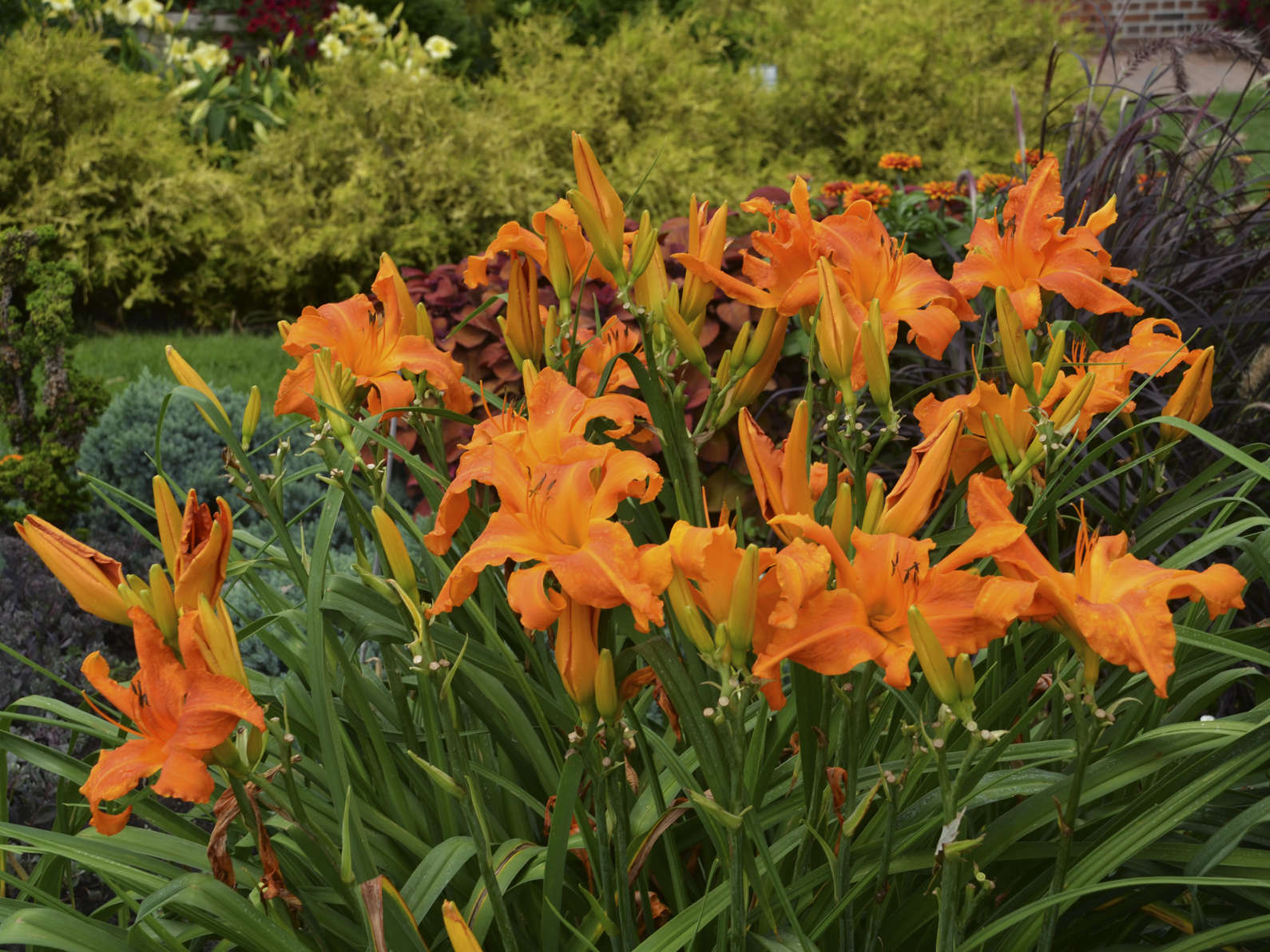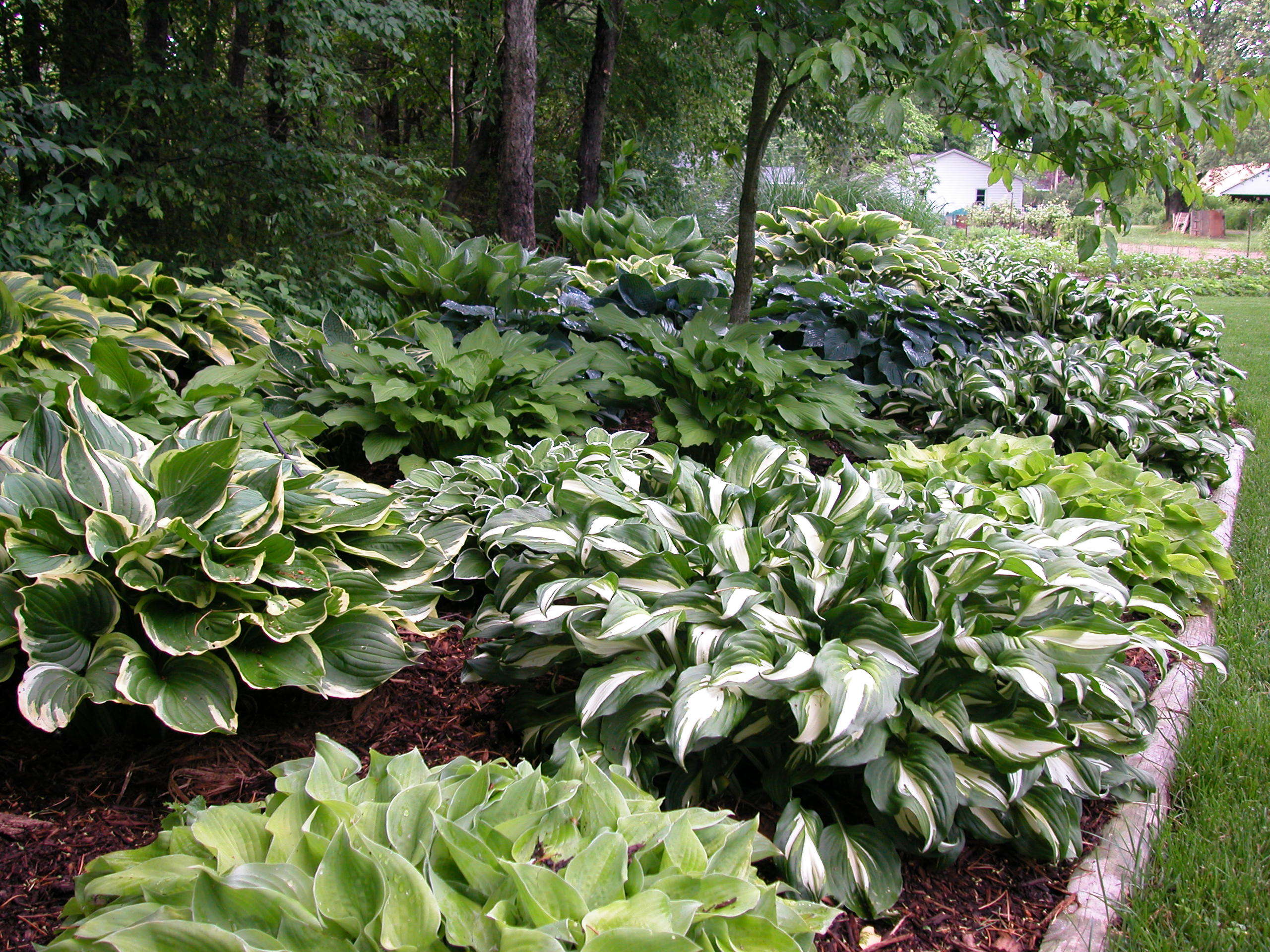Step 4: Garden Design Elements
How to Design & Grow Your own Garden
For most gardeners, deciding where to put the plants is the most exciting and, at the same time, most worrisome part of perennial gardening. It's exciting because you have the potential to create a masterpiece. It's worrisome because there's generally some doubt that goes along with the decision process. The truth is, perennials are a very forgiving group of plants. If you decide a certain perennial would look better in a different part of the garden, it's quite practical to dig that plant out in the spring and transplant it to another location. Experienced gardeners move plants all the time; it's simply a matter of tweaking previous work — similar to improving a recipe until it's perfect.
As you decide how to arrange plants in a new garden or add plants to an existing garden consider the design factors described in this section.
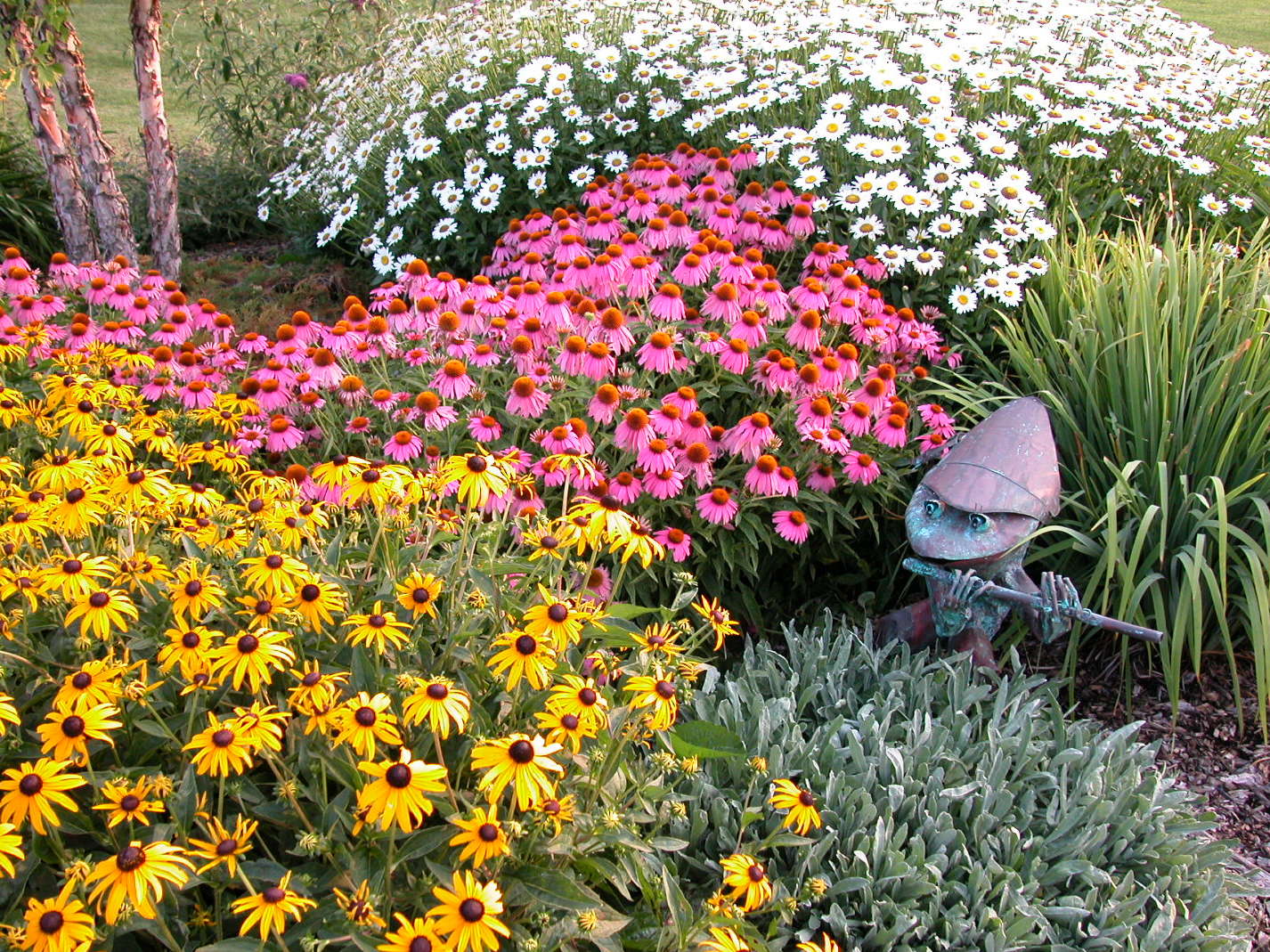
Color
More than any other design element, color is what our eye is most attracted to in the garden. We know instantly when colors visually flow or are unsettling. Much of learning to design with color comes from trial and error. However, there are a few basic principles you can use as guidelines.
If you look at an artist’s color wheel, it is composed of all of the colors in the rainbow. Those that are positioned next to each other on the color wheel are called “harmonious”; they naturally combine well because they share a hue. Red, orange, and yellow are harmonious colors. Colors that are positioned opposite one another on the color wheel are called “contrasting” because they do not share any hues. Examples are red/green, orange/blue, and yellow/purple.
Warm colors such as red, orange, and yellow evoke a feeling of excitement and passion in the garden. Visually, they tend to advance or appear closer than they really are. Use them to draw attention to a special place in the garden, or at the front of the garden to make it seem more intimate.
Cool colors such as green, blue, and purple are calming, relaxing colors that make the garden seem quiet and serene. Visually, cool colors tend to recede or appear further away than they really are. Use them in places you don’t want to be so noticeable, or at the back of the garden to make it seem larger.
The color white draws more attention visually than any other color including warm ones. Use it sparingly in the garden to contrast with or separate other colors.
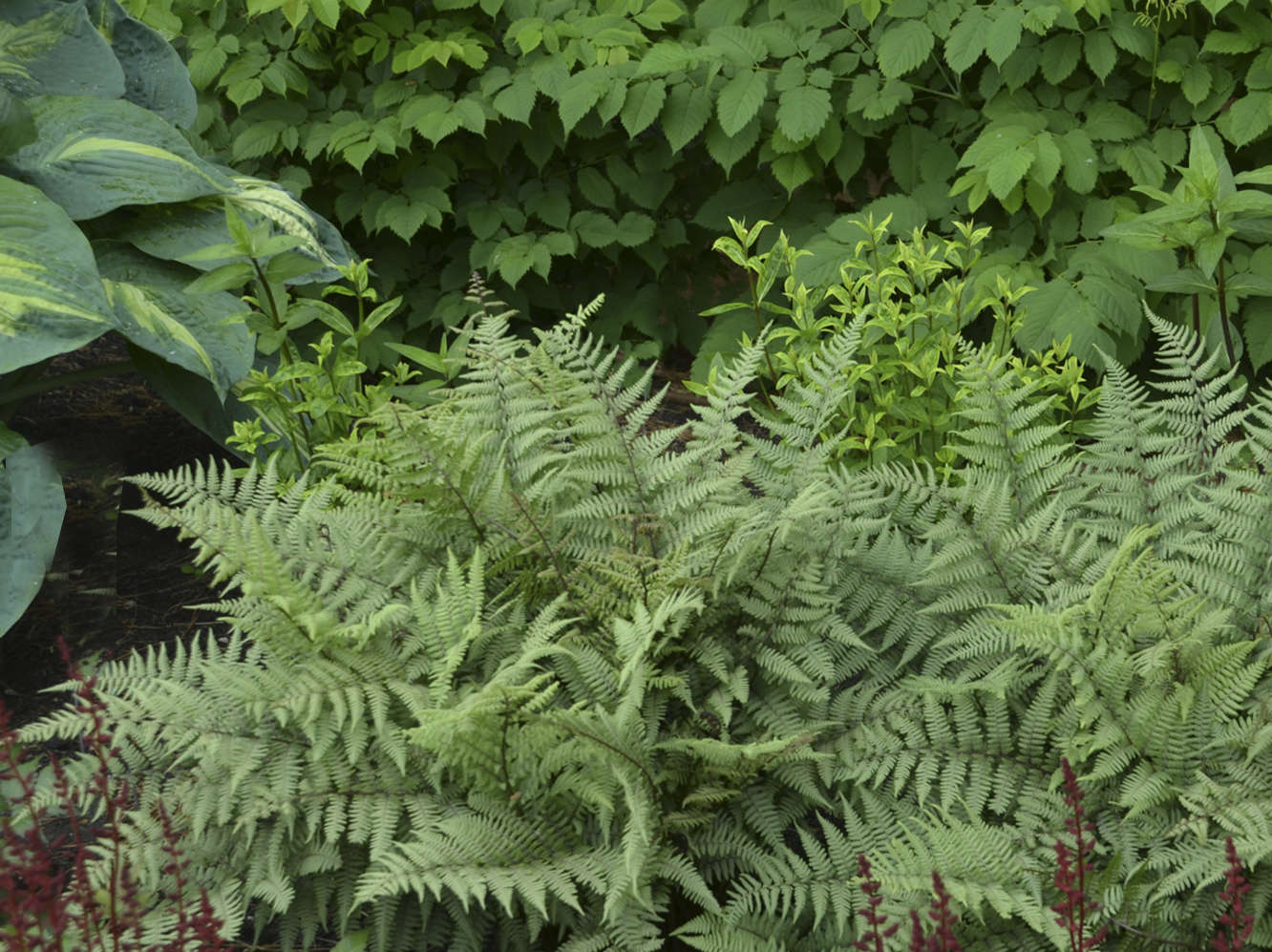
Texture
When we speak of texture as a design element in the garden, we are not talking about how something feels, but rather how it looks like it feels. A spiky Iris leaf may look sharp, but it is actually smooth to the touch. Plant texture relates to the size, shape, and orientation of its leaves. There are three types of plant texture: fine, medium, and coarse.
- Plants with coarse foliage are those with large leaves and/or large gaps between the leaves. Hostas, Bergenia, and Tall Bearded Irises are all coarse foliage plants. Since they carry the most visual weight in the garden (we tend to notice them first), they should be used sparingly and should be spaced out. Using too many coarse textured plants in the garden makes it feel intimidating and small.
- Plants with fine foliage are those with small, feathery, or narrow leaves with few gaps between them. Ferns, many groundcovers, and Silver Mound Artemisia are all fine foliage plants. They carry little weight visually and when used alone they tend to blur together into one large mass of plants. However, when they are used to complement coarse foliage plants, they help to create a visually cohesive look for the space.
- Plants of medium texture are those that fall somewhere on the spectrum between coarse and fine texture; their leaves are not large, but are not very small either. Many plants fall into this category and it’s a good chance that what you have growing in your garden now are medium textured plants. The trick is to strategically add both coarse and fine textured plants between them to create a balanced look.
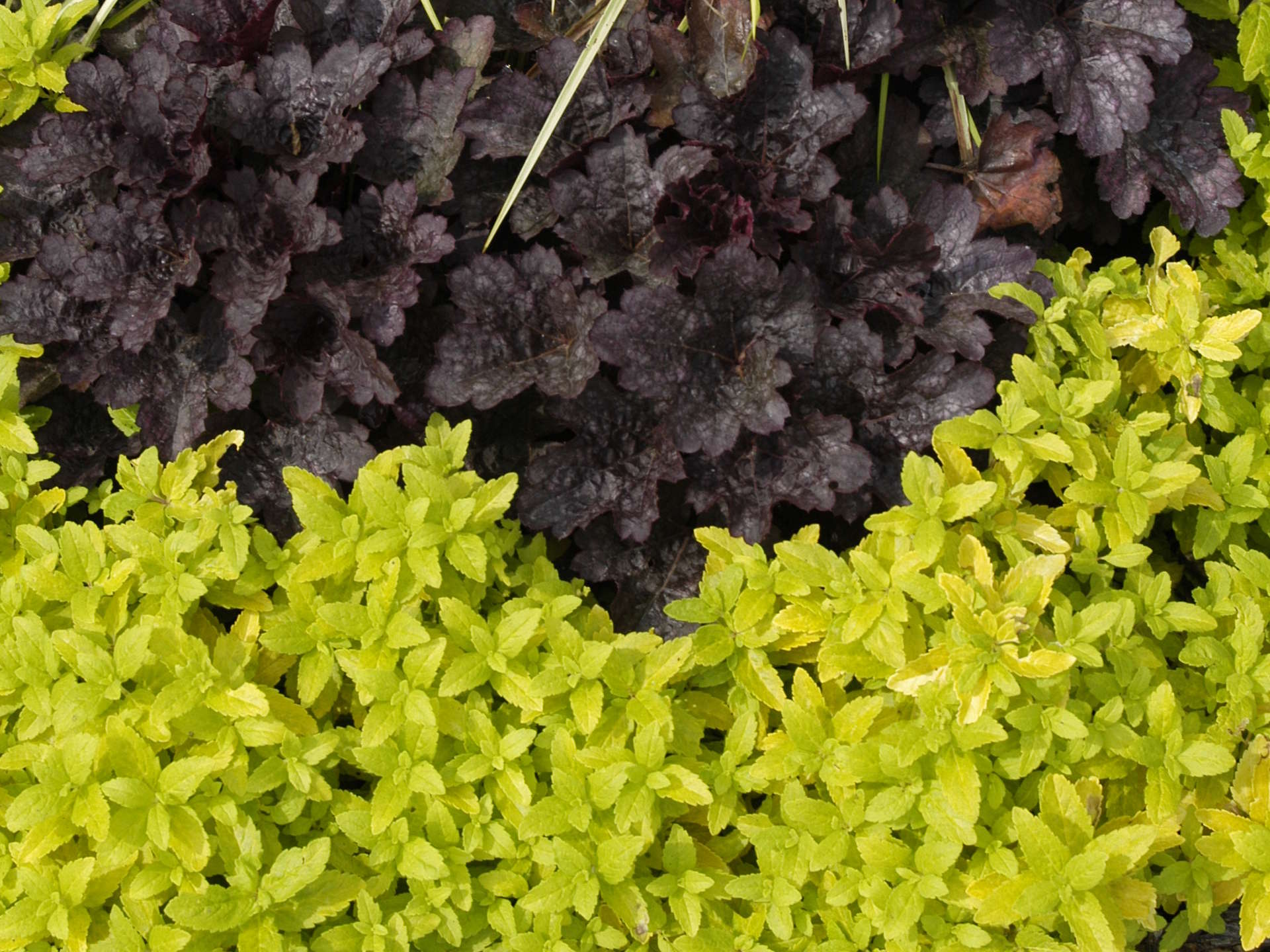
Contrast
A well-designed garden offers contrast in color, texture, and form. Combining contrasting colors (those opposite each other on the color wheel) creates visual interest and draws the viewer into the garden to take a better look up close. A grouping of bright yellow Coreopsis planted in front of a hedge of blue Delphiniums is visually striking because of the contrast between the warm and cool tones. Harmonious color palettes can be equally beautiful in the garden, but then the contrast of texture and form play a more critical role.
Contrast in texture is also a critical design element. We learned above that texture relates to the size, shape, and orientation of a plant’s leaves. To achieve contrast in texture, combine plants that have bold, coarse foliage with those that have fine, narrow leaves. A classic example of this is pairing a large leaf Hosta with ferns. The contrast in texture sets off the beautiful characteristics of each plant. You might not have noticed the delicate details of the ferns if they had been grouped together with other finely textured plants.
To achieve contrast in form, it is important to combine plants with different habits (spiky, round, flat, mound, fountain-like) to keep them from all blending together into one large mass. Ornamental grasses and spiky plants like Irises are great for breaking up a monotonous grouping of mounding plants. You could also try strategically placing a tall, narrow pot in a patch of prostrate, spreading plants to achieve great contrast in form. Use this technique to draw attention to a particularly interesting part of the garden or to lead the eye to a fantastic view.
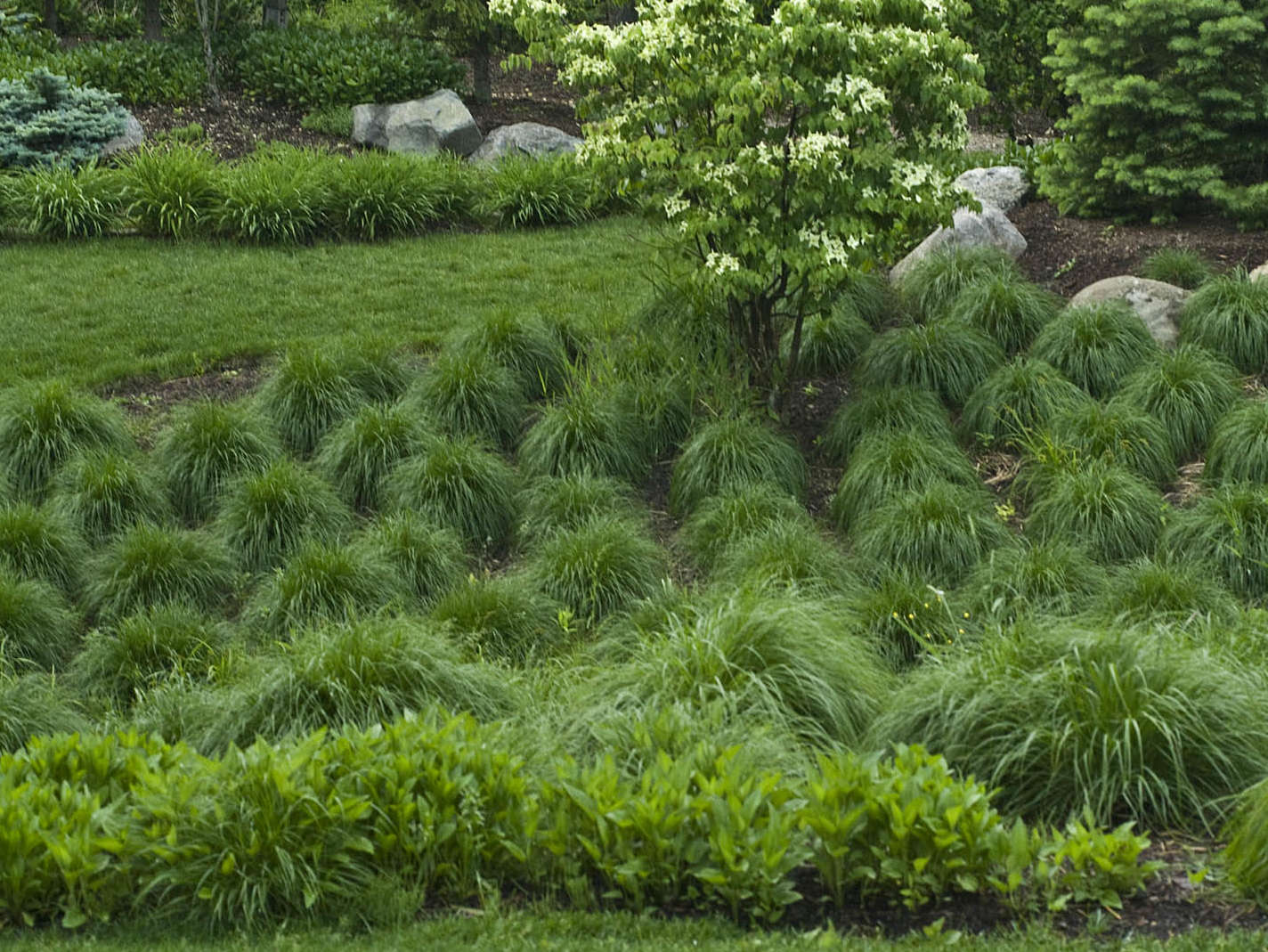
Repetition
Repetition in the garden can be as subtle as repeating a planting of pink daylilies throughout the flower border or as bold as spacing identical large, cobalt blue urns every few feet along a garden path. Either way, repetition of color and form throughout the garden serves to pull the eye in and lead the viewer visually through the space. A bold hosta specimen repeated strategically along a wooded path, for instance, beckons visitors to take a walk and see where the path may lead.
Repetition of color and form also visually unifies the space and prevents the look of randomness in the garden. This is an important tool for gardeners who love to collect plants but still want their gardens to have a cohesive look. If they limit the plants they collect to a set of three basic colors, there is a good chance the repetition of color will unite the space.
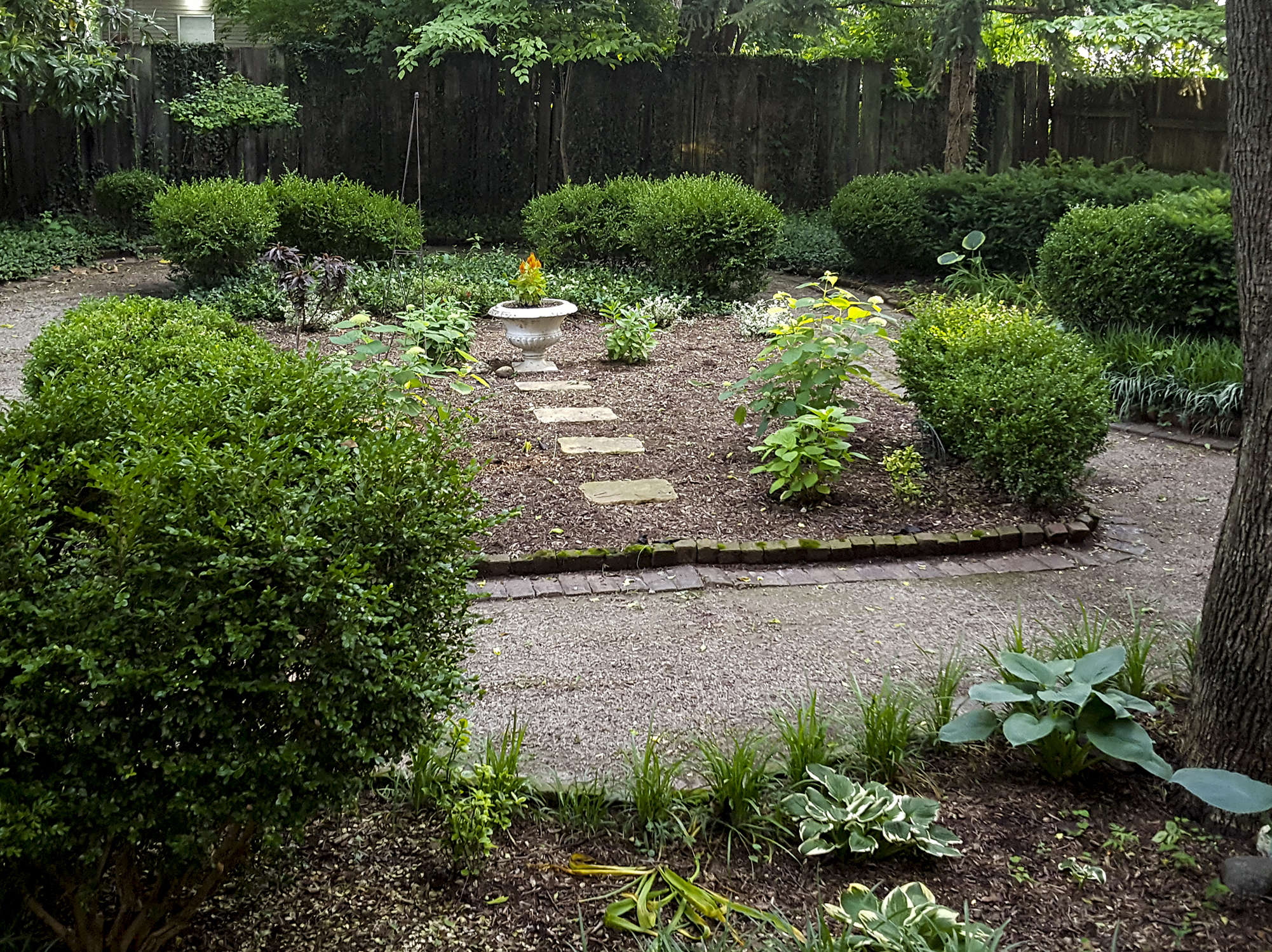
Balance
Balance or symmetry in the garden relates to the placement of plants or objects that carry visual weight. In a glance, our eye knows whether or not a garden design is balanced. If the left side of a garden border is filled with bold, hot colored plants and the right side contains mostly green plants, the left side will carry the most visual weight and our eye will rest there. Conversely, if the hot colored plants are positioned so they carry equal visual weight on both sides of the border, it will look balanced and our eye will view it as one unified space.
Balance in the garden can also be achieved through plant size by including equivalent plant groupings on each side of the garden. For example, if a large clump of ornamental grass is planted on the left side of the border, it will be necessary to plant a large shrub or its equivalent on the opposite side to achieve a balanced visual weight. The grass and shrub do not have to be planted directly across from one another but should be within the same line of sight. This is a common way to achieve balance in an informal garden. To create a balanced look in a formal garden, mirror the plantings (plant exactly the same thing) on both sides of the garden, entryway, or path.
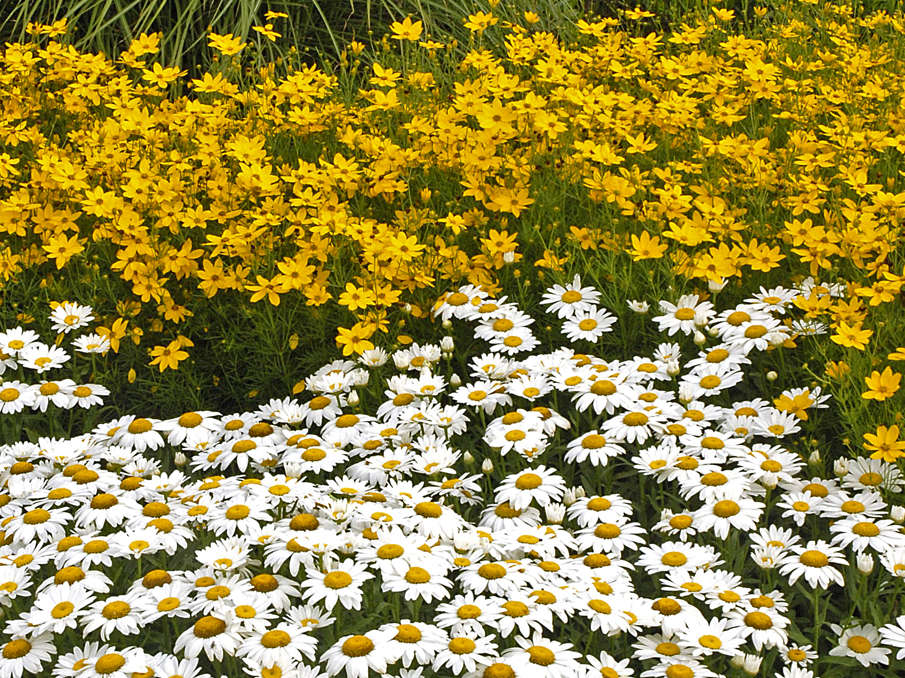
Form
Form relates to the shape and size of a plant or flower. A plant’s form is commonly referred to as its habit, and there are three basic plant habits: vertical/upright, mounding, and horizontal/prostrate. Balanced garden designs include plants of all three forms. Juxtaposing plants with opposite forms creates a delightful contrast and makes the garden more visually appealing. Alternately, a grouping of Tall Bearded Irises can visually balance a large Yucca since both plants share a similar form.
Perennials with similar flower forms can also be used to visually unite a planting. For example, a large grouping of coneflowers visually balances a patch of daisies because they have the same flower form, even though the colors are different. Similarly, Delphiniums can balance Foxgloves since they both carry their flowers on tall spikes.
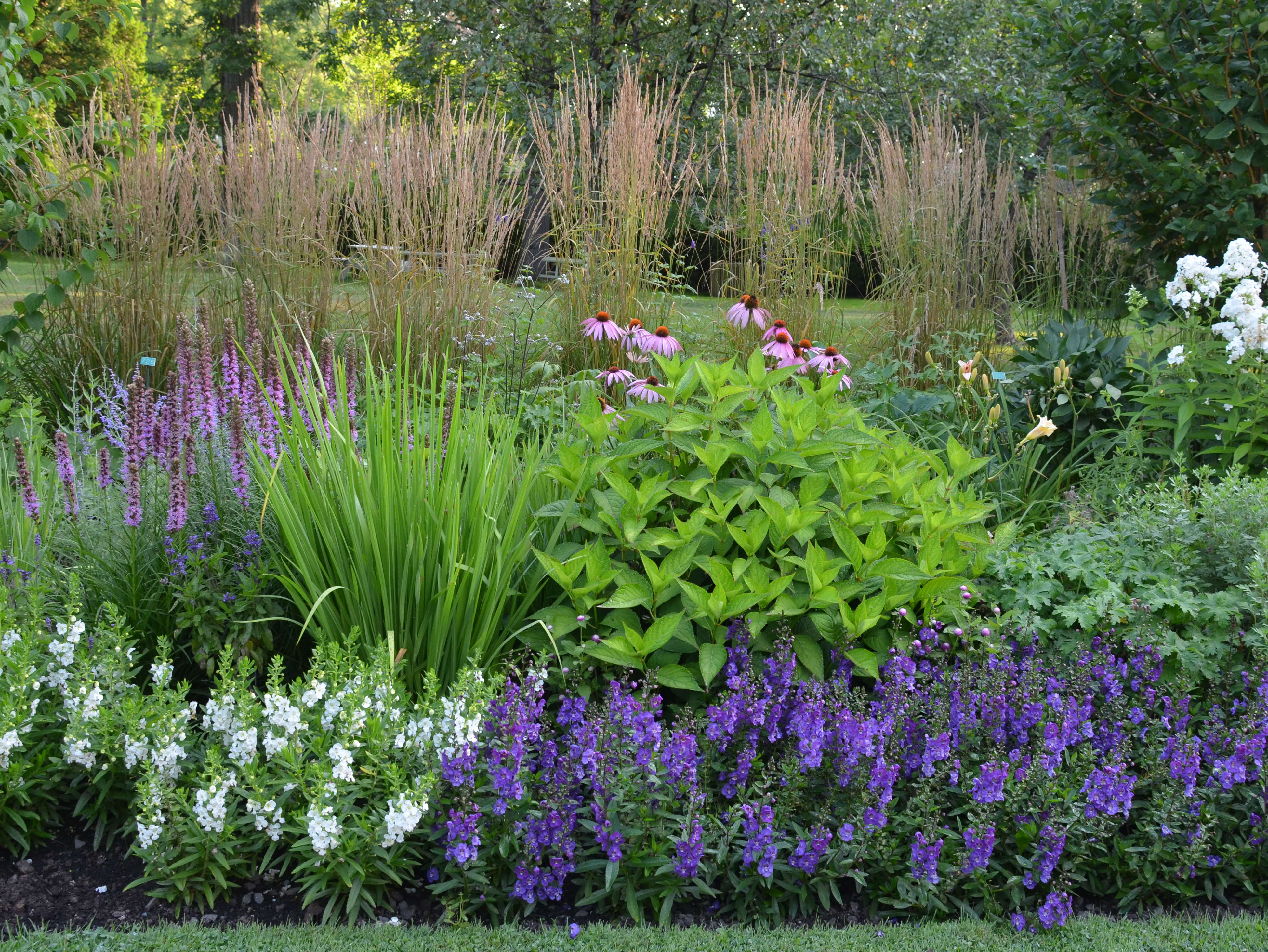
Size
Size is relative and it can relate to the size of your garden, the plants in it, or leaf and flower size. All of these things contribute to the balanced look of your garden. Great garden designs combine plants of various sizes.
Garden size is often determined by one’s personal taste, budget, and ability to maintain it. If you are gardening in a small space such as a courtyard, using smaller scale, cool colored plants will help to make the space look larger. A single large specimen plant could be used as a focal point in this case. Using many large scale plants in a small space can make it feel congested and overwhelming. Conversely, if your garden is vast, using many large plants would be appropriate in scale.
When planning a new flower border, many people choose the “layered” look where they position the shortest plants in the front and the tallest ones in the back. This design keeps favorite plants from being hidden behind others, but it can look a bit regimented if the layers are too precise. Try planting a few “see through” plants (those with tall, wispy flowers but short foliage like Baby’s Breath) towards the front of the garden to help blend the layers together.
Plants with bold foliage or very large flowers can act as focal points or specimens in the garden. For example, the flowers of perennial hibiscus can measure up to a foot across, making it an outstanding specimen in the late summer garden.
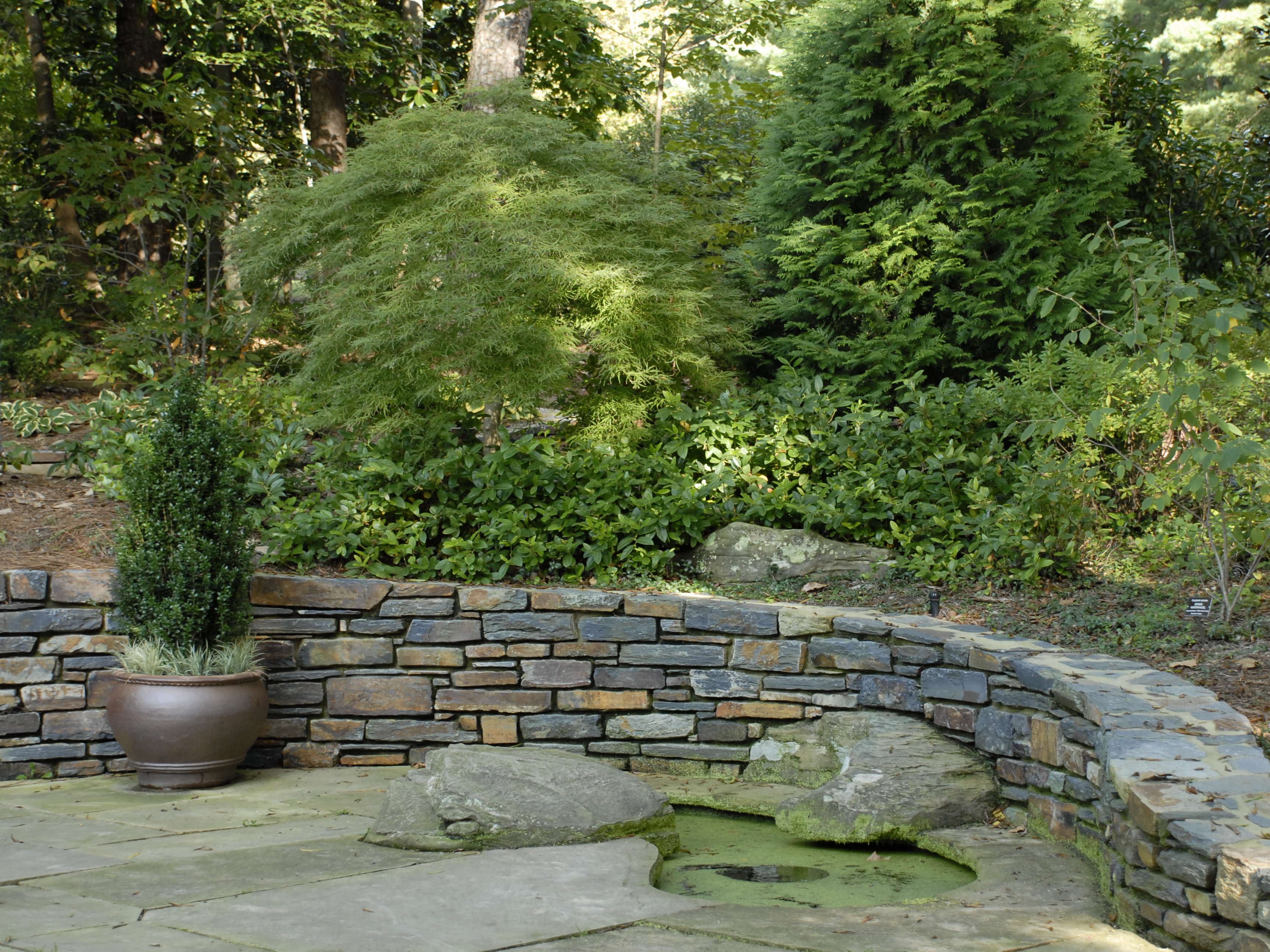
Structure
Structure in the garden comes in several forms. The most obvious way to create structure in the garden is to add a few “hardscape” elements such as an arbor, pergola, trellis, retaining wall, fence, edging, or water feature. The size of the structure should be proportionate to the other features in the garden, and their styles should be similar. A small decorative urn would be perfectly suited to a small patio, but would go unnoticed on an expansive veranda. Similarly, a rustic picket fence would be appropriate in a cottage or woodland garden, but would look out of place in a formal garden.
Structure can also be achieved with architecturally significant plant material. Some plants with architectural significance include large ornamental grasses with decorative plumes, those with tall flower spikes such as Gayfeather (Liatris), and those with sword-like foliage like a Yucca. Evergreen perennials serve the dual purpose of providing structure in the garden in both summer and winter. In addition to perennials, other plant material such as trees, shrubs, and vines provide a great deal of structure in the garden and help to visually anchor the space.
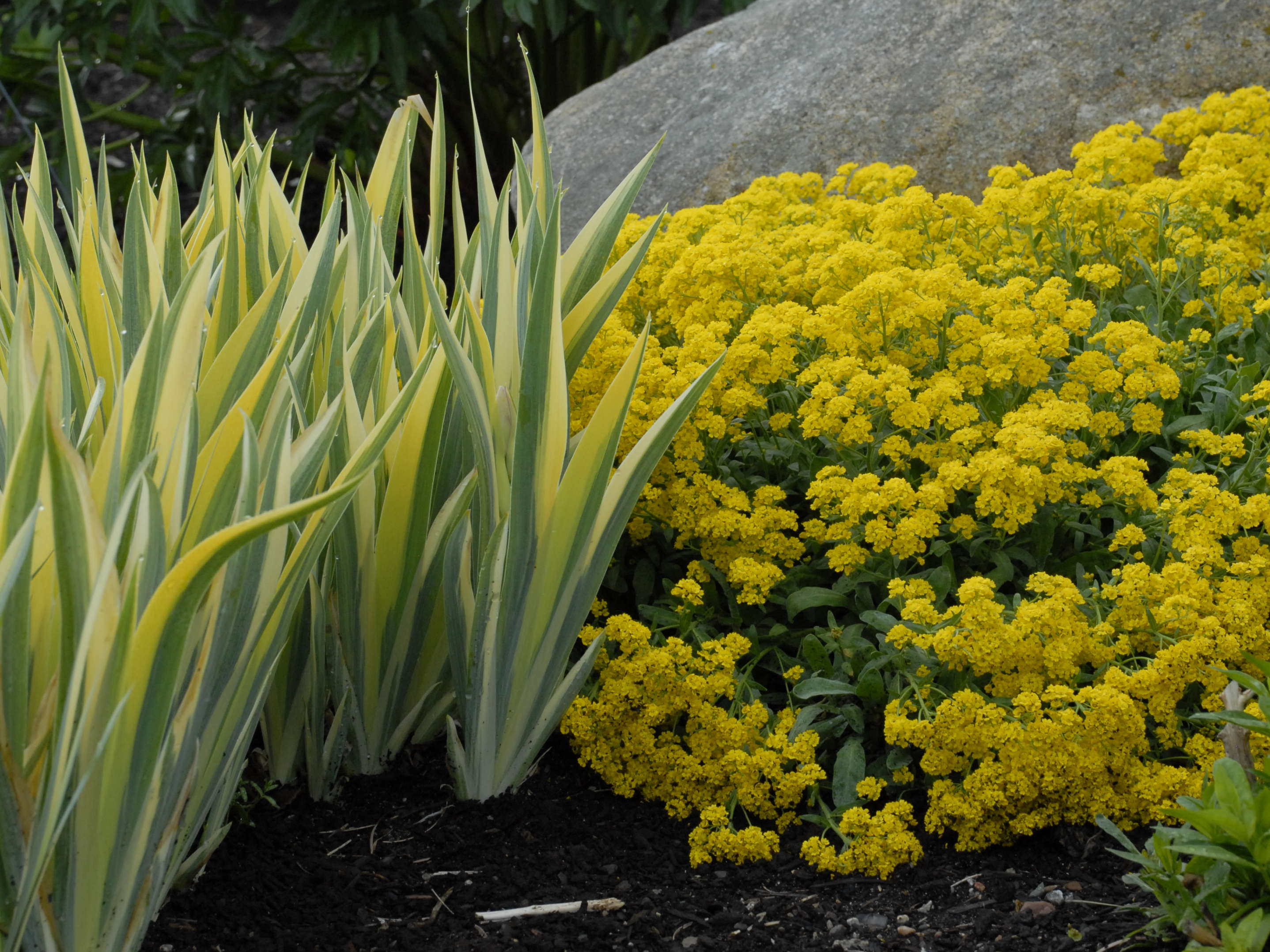
Combining Plants
Learning how to combine plants effectively can be easy if you use your knowledge of all the garden design principles mentioned here, especially color, texture, contrast, and form. Great combinations can be planned out ahead of time based on these principles, but they also can appear as pleasant surprises in the garden. Sometimes your favorite combination turns out to be something you didn’t plan for at all, something that happened through the magic of nature.
One of the best references on how to combine perennials effectively is a book written by award winning author and garden designer Colston Burrell called Perennial Combinations—Stunning Combinations That Make Your Garden Look Fantastic Right from the Start. Burrell stresses that above all, the plants you combine must share a need for the same cultural requirements (light, water, soil). His book presents an expansive, picturesque, and informative tour through combinations based on color, season of bloom, attracting nature, and more.
In our Perennial Encyclopedia, you will also find recommended companion plants for every perennial listed there. These are plants that share similar cultural requirements and combine naturally with one another. Garden centers, magazines, botanical gardens, and even your neighbor’s yard can also be great sources of inspiration. Don’t be afraid to copy the ideas you see there in your own garden. Imitation is the greatest form of flattery!
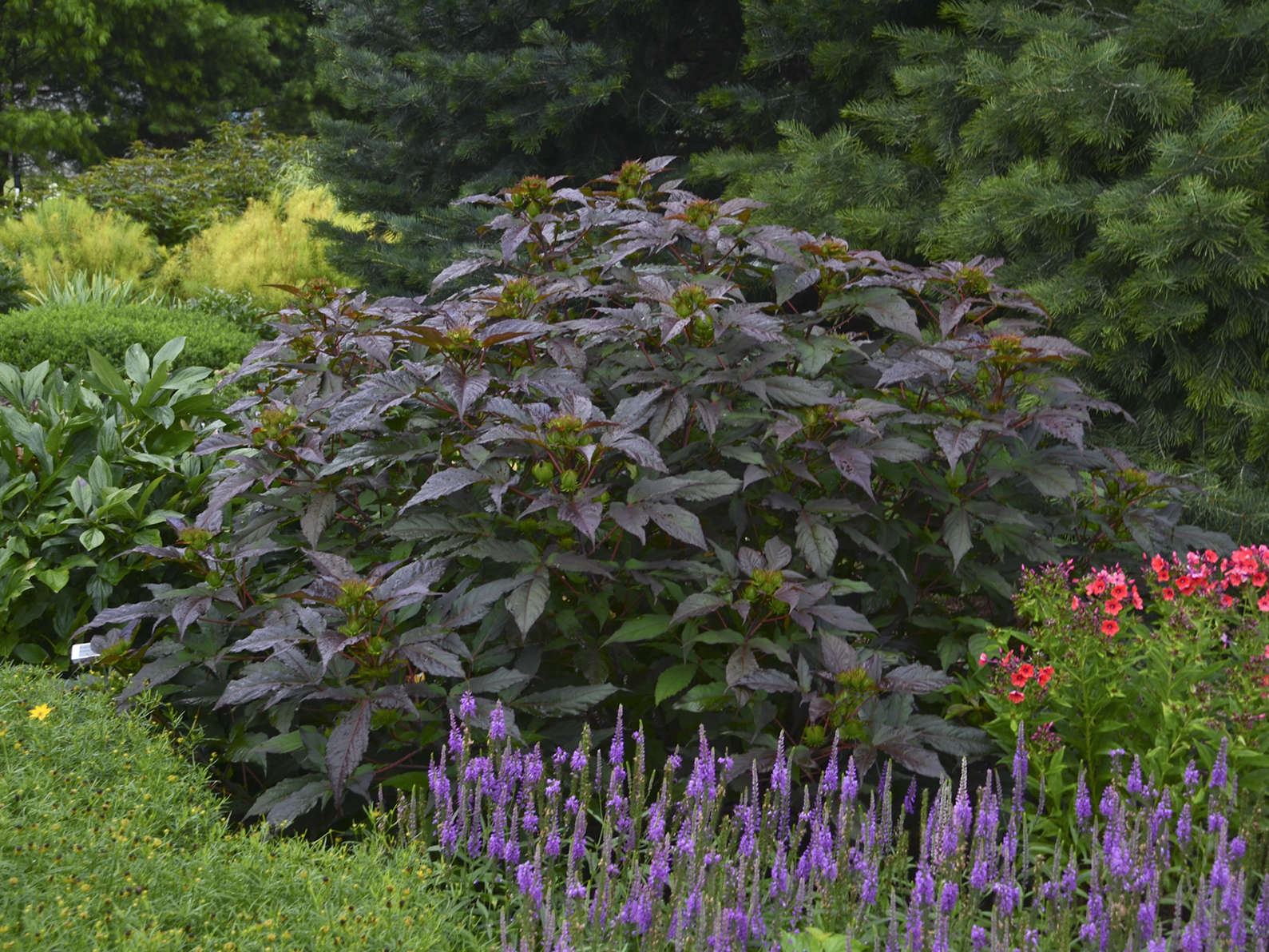
Succession Planting
Succession planting is the practice of designing with plants that have different bloom times so there’s always something flowering in the garden. Though it can be one of the most challenging technical elements of garden design, it is also one of the most fun to learn (and it gives gardeners a great excuse to head back to the garden center for more plants!).
Before you purchase plants for your garden, do your research and learn what the peak season of interest is for the plants you like. Combine those with similar bloom times, but be sure to position them near other plants that will bloom earlier or later so there’s always something in bloom. Intersperse plants with appealing foliage or form to ensure continuous visual interest all year long.
When shopping at the garden center, keep in mind that people tend to impulsively buy plants that are colorful and blooming. If you only make one trip to the garden center in spring, your garden may end up being filled with spring blooming plants but may hold little visual interest later in the year. That is why it is important to shop for plants throughout the growing season, picking up plants that bloom at different times. Keep in mind that some plants may be blooming out of their natural sequence at the garden center and may bloom at a different time in your own garden.
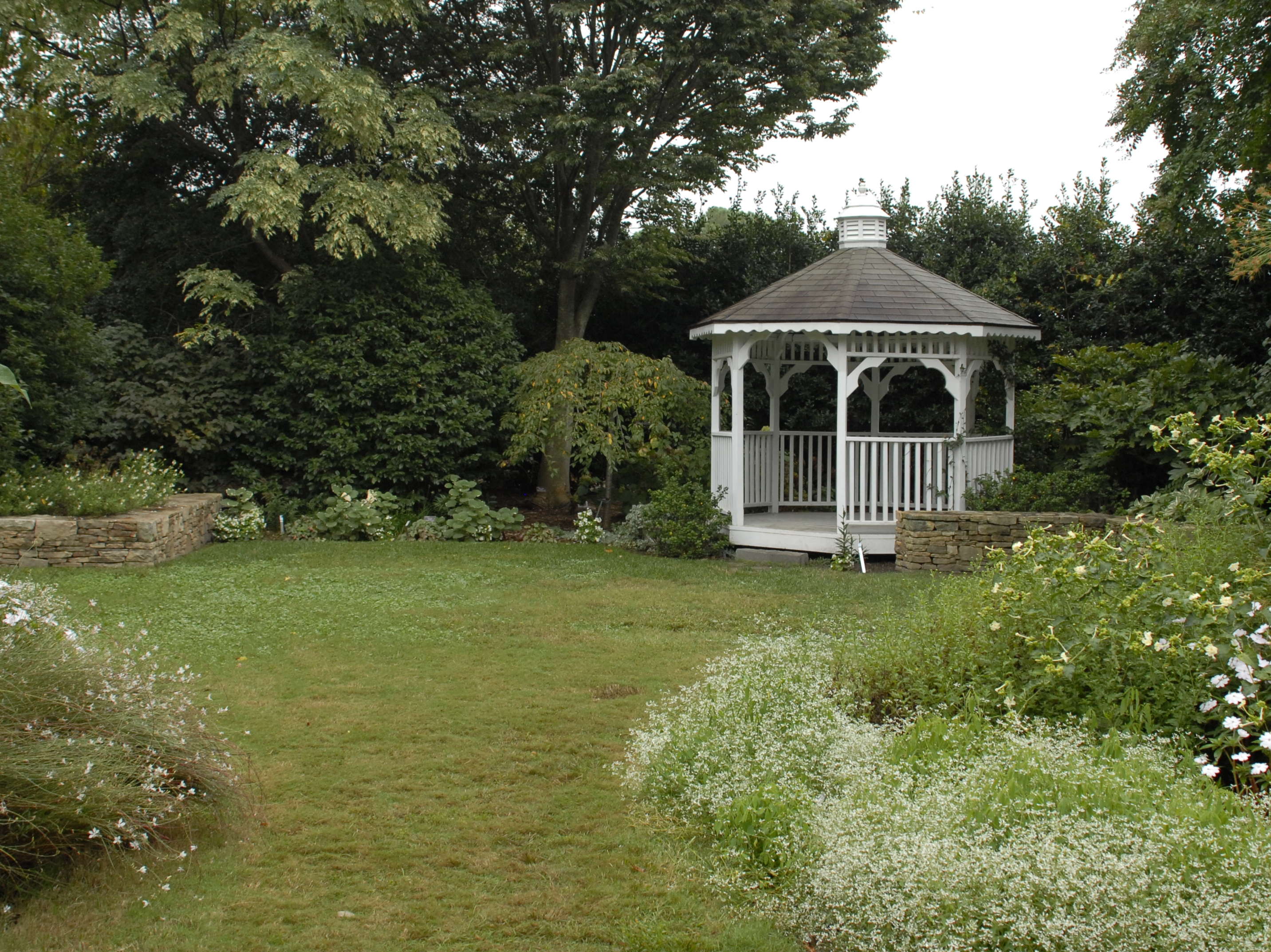
Creating a Focal Point
An elaborate statue, a grouping of mature Blue Spruce trees, a comfortable bench, or a flashy perennial Hibiscus are all examples of things that can serve as a focal point in the garden. They carry a good deal of visual weight because of their size, shape, or color and they provide a place for the eye to rest when taking in the view.
Proper placement and scale are vital to the effectiveness of a focal point. If well-placed, it becomes a destination in the garden, like a bench at the end of the path. If it’s too small, it won’t be noticed, but if it’s too large, it will overwhelm the space. You may need to experiment with a few items before you settle on a proper focal point for the space. Keep in mind that the focal point of your garden can be a borrowed view from your neighbor’s landscape. If they have a gorgeous flowering Dogwood you can see from your deck, frame the view of their Dogwood with plants in your own yard.
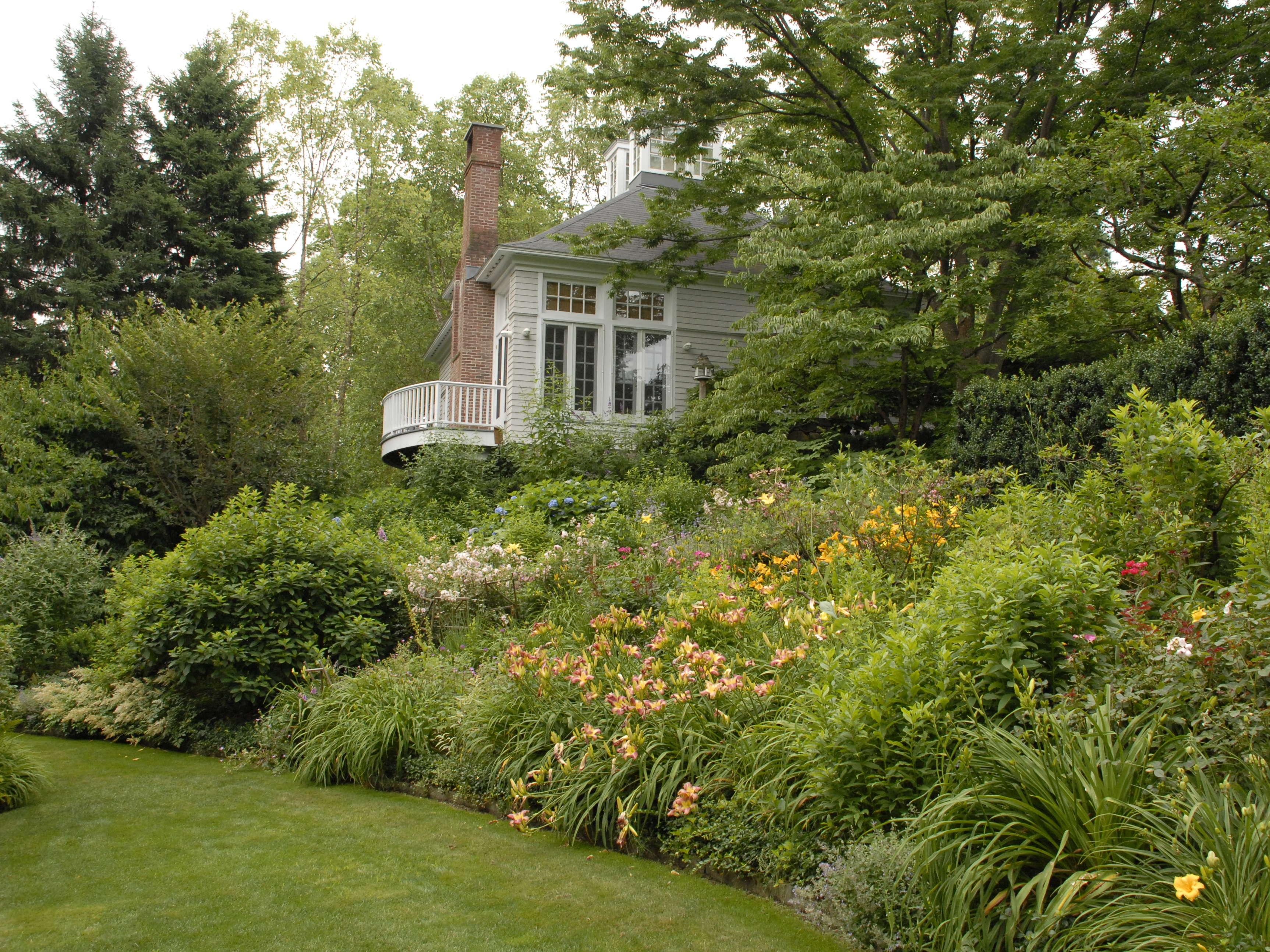
Designing from a Viewpoint
When designing a new garden bed, it is important to consider where the garden will be viewed from most often and then gear your design towards that viewpoint. Of course, your garden should look good from all angles, but your main viewpoint is the most important. Will you be looking at the garden most often when you are relaxing on the deck? Pulling up in the driveway? Looking out the kitchen window? Where you position your focal point, specimen plants, and even your favorite plants will be influenced by this main viewpoint. If a statue will be your focal point, be sure it is turned to face your main viewpoint. If your kitchen window is your main viewpoint, look out and see if the view of your new garden would be blocked by the swing set or other obstacle.
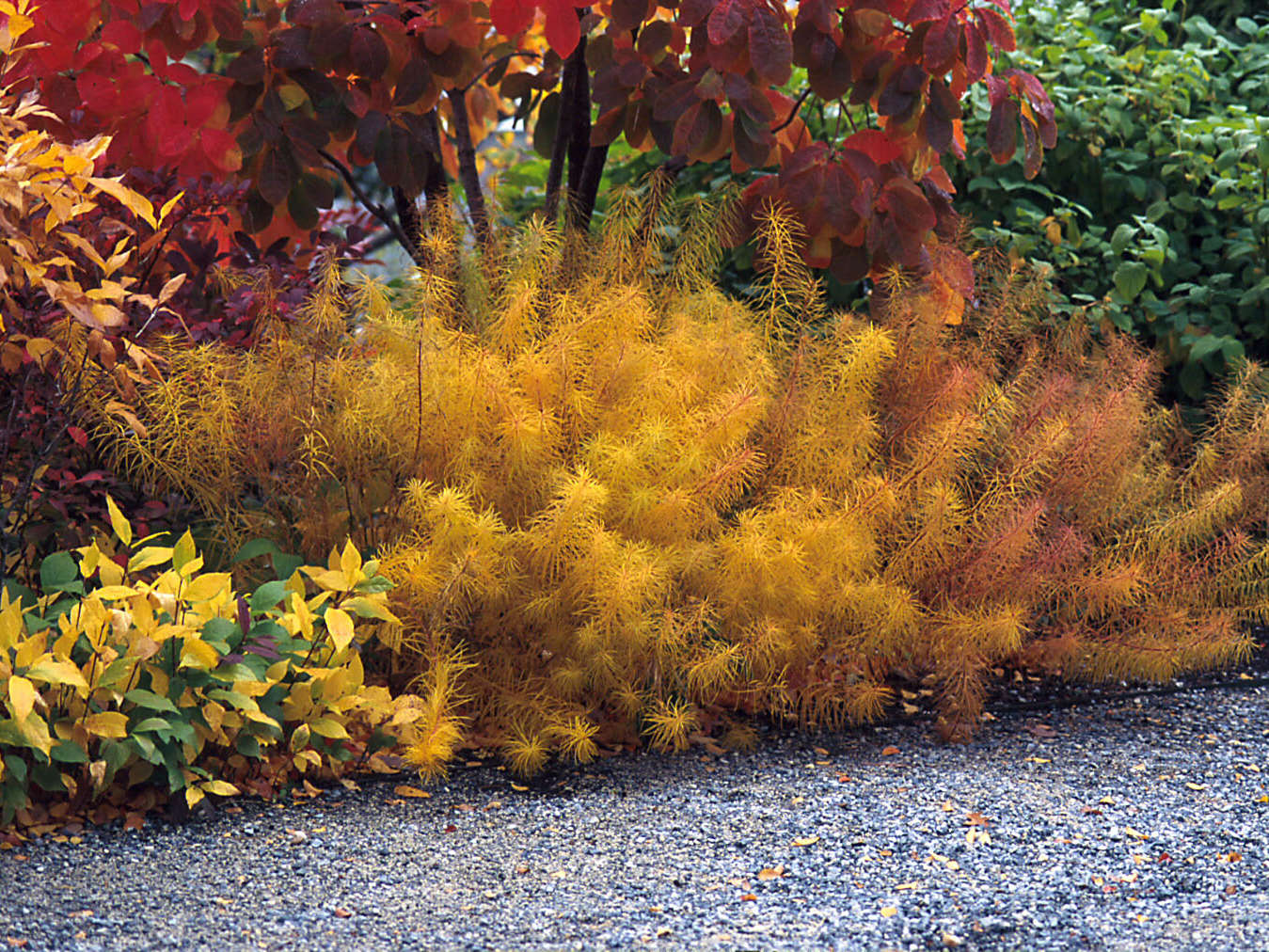
Planning for Seasonal Interest
In the Midwest, one of the things people look forward to the most is the change of seasons. Spring bulbs bring a renewed sense of hope, summer flowering perennials offer a riot of color, the fall color of Maples activates our nesting instincts, and the bare branches of winter suggest a time of rest. The well-designed garden offers visual interest all year round, even in the heart of winter.
Succession planting helps to ensure there is something in bloom from spring through fall, but as the cooler weather arrives, seed heads and foliage color take center stage. Did you know that many perennials offer fall color?
During the winter months, when most perennials have gone dormant for the year, some continue to provide visual interest. One of the best features of ornamental grasses is that they remain standing through winter, standing as glorious golden beacons in the crisp white snow. Evergreen perennials also provide winter interest provided they aren’t buried under the snow!
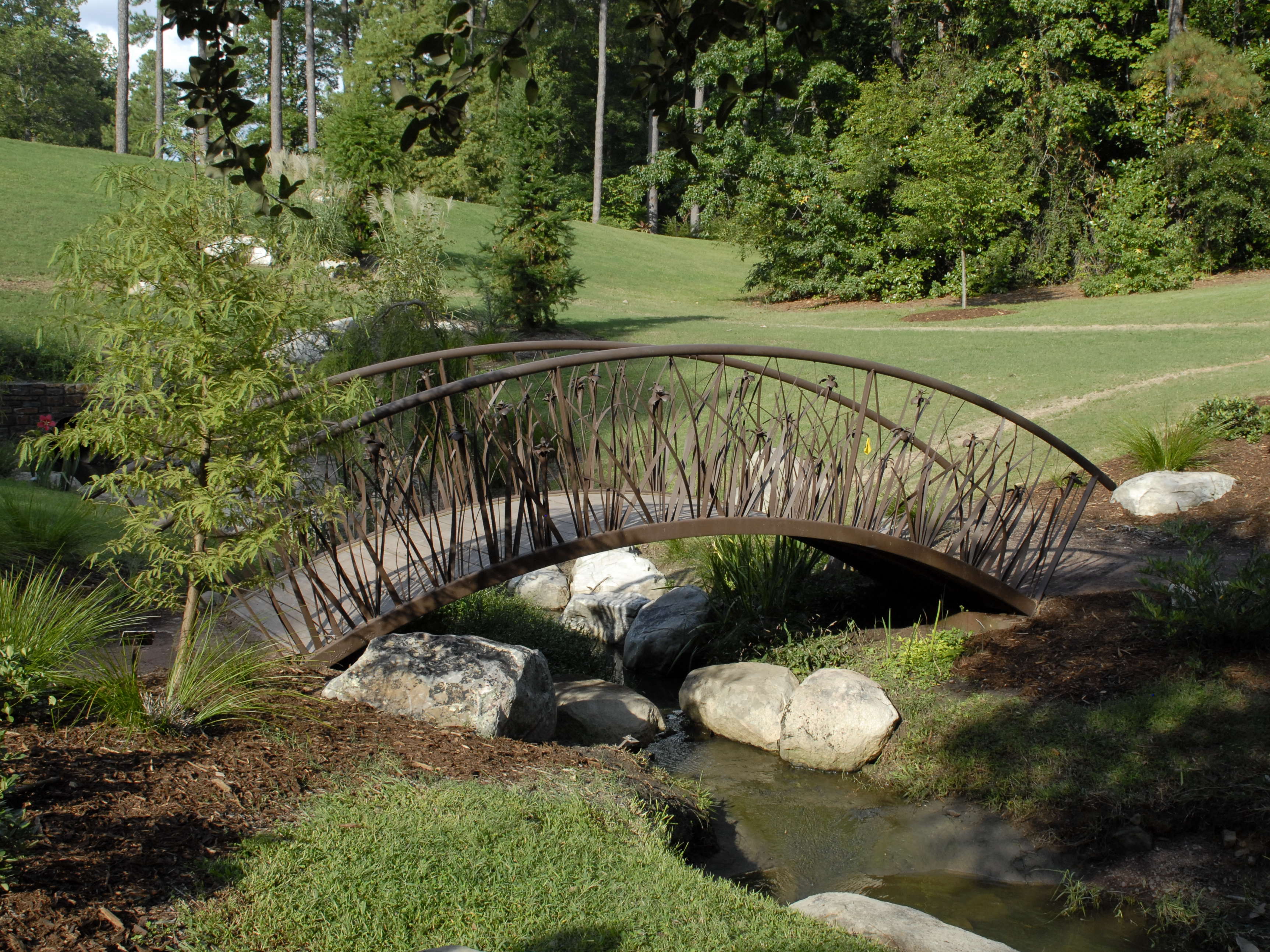
Incorporating Garden Art
Decorating the garden with art and ornaments is like putting the icing on the cake. It enhances the design and provides visual interest when plants are not in bloom. The art you choose for your garden expresses your personality more than any other design element. It’s a good idea to choose art and ornaments that coordinate with the style you’ve chosen for your garden. The rustic sunflower stakes shown here are perfectly matched to the cottage garden filled with Black-Eyed Susans. Likewise, the blue heron statue looks ready to pluck a fresh fish from the pond garden shown here.
Garden art can serve as a focal point in the landscape or it can be used to add structure and color to otherwise drab areas. It can also be used to set the mood of the garden (fun, contemplative, or serene), add sound (wind chimes, waterfalls, fountains), or bring back memories. If you choose to use more than one piece of art in the garden, make sure they all share a common element such as color, style, or material so they create a unified look in the space.
Step 1: Perennials 101
Step 2: Getting Started
Step 3: Find Your Style
Step 5: Building Your Garden
Step 6: Caring For Your Garden
For most gardeners, deciding where to put the plants is the most exciting and, at the same time, most worrisome part of perennial gardening. It's exciting because you have the potential to create a masterpiece. It's worrisome because there's generally some doubt that goes along with the decision process. The truth is, perennials are a very forgiving group of plants. If you decide a certain perennial would look better in a different part of the garden, it's quite practical to dig that plant out in the spring and transplant it to another location. Experienced gardeners move plants all the time; it's simply a matter of tweaking previous work — similar to improving a recipe until it's perfect.
As you decide how to arrange plants in a new garden or add plants to an existing garden consider the design factors described in this section.
ColorMore than any other design element, color is what our eye is most attracted to in the garden. We know instantly when colors visually flow or are unsettling. Much of learning to design with color comes from trial and error. However, there are a few basic principles you can use as guidelines. If you look at an artist’s color wheel, it is composed of all of the colors in the rainbow. Those that are positioned next to each other on the color wheel are called “harmonious”; they naturally combine well because they share a hue. Red, orange, and yellow are harmonious colors. Colors that are positioned opposite one another on the color wheel are called “contrasting” because they do not share any hues. Examples are red/green, orange/blue, and yellow/purple. Warm colors such as red, orange, and yellow evoke a feeling of excitement and passion in the garden. Visually, they tend to advance or appear closer than they really are. Use them to draw attention to a special place in the garden, or at the front of the garden to make it seem more intimate. Cool colors such as green, blue, and purple are calming, relaxing colors that make the garden seem quiet and serene. Visually, cool colors tend to recede or appear further away than they really are. Use them in places you don’t want to be so noticeable, or at the back of the garden to make it seem larger. The color white draws more attention visually than any other color including warm ones. Use it sparingly in the garden to contrast with or separate other colors. |
 TextureWhen we speak of texture as a design element in the garden, we are not talking about how something feels, but rather how it looks like it feels. A spiky Iris leaf may look sharp, but it is actually smooth to the touch. Plant texture relates to the size, shape, and orientation of its leaves. There are three types of plant texture: fine, medium, and coarse.
|
 ContrastA well-designed garden offers contrast in color, texture, and form. Combining contrasting colors (those opposite each other on the color wheel) creates visual interest and draws the viewer into the garden to take a better look up close. A grouping of bright yellow Coreopsis planted in front of a hedge of blue Delphiniums is visually striking because of the contrast between the warm and cool tones. Harmonious color palettes can be equally beautiful in the garden, but then the contrast of texture and form play a more critical role. Contrast in texture is also a critical design element. We learned above that texture relates to the size, shape, and orientation of a plant’s leaves. To achieve contrast in texture, combine plants that have bold, coarse foliage with those that have fine, narrow leaves. A classic example of this is pairing a large leaf Hosta with ferns. The contrast in texture sets off the beautiful characteristics of each plant. You might not have noticed the delicate details of the ferns if they had been grouped together with other finely textured plants. To achieve contrast in form, it is important to combine plants with different habits (spiky, round, flat, mound, fountain-like) to keep them from all blending together into one large mass. Ornamental grasses and spiky plants like Irises are great for breaking up a monotonous grouping of mounding plants. You could also try strategically placing a tall, narrow pot in a patch of prostrate, spreading plants to achieve great contrast in form. Use this technique to draw attention to a particularly interesting part of the garden or to lead the eye to a fantastic view. |
 RepetitionRepetition in the garden can be as subtle as repeating a planting of pink daylilies throughout the flower border or as bold as spacing identical large, cobalt blue urns every few feet along a garden path. Either way, repetition of color and form throughout the garden serves to pull the eye in and lead the viewer visually through the space. A bold hosta specimen repeated strategically along a wooded path, for instance, beckons visitors to take a walk and see where the path may lead. Repetition of color and form also visually unifies the space and prevents the look of randomness in the garden. This is an important tool for gardeners who love to collect plants but still want their gardens to have a cohesive look. If they limit the plants they collect to a set of three basic colors, there is a good chance the repetition of color will unite the space. |
 BalanceBalance or symmetry in the garden relates to the placement of plants or objects that carry visual weight. In a glance, our eye knows whether or not a garden design is balanced. If the left side of a garden border is filled with bold, hot colored plants and the right side contains mostly green plants, the left side will carry the most visual weight and our eye will rest there. Conversely, if the hot colored plants are positioned so they carry equal visual weight on both sides of the border, it will look balanced and our eye will view it as one unified space. Balance in the garden can also be achieved through plant size by including equivalent plant groupings on each side of the garden. For example, if a large clump of ornamental grass is planted on the left side of the border, it will be necessary to plant a large shrub or its equivalent on the opposite side to achieve a balanced visual weight. The grass and shrub do not have to be planted directly across from one another but should be within the same line of sight. This is a common way to achieve balance in an informal garden. To create a balanced look in a formal garden, mirror the plantings (plant exactly the same thing) on both sides of the garden, entryway, or path. |
 FormForm relates to the shape and size of a plant or flower. A plant’s form is commonly referred to as its habit, and there are three basic plant habits: vertical/upright, mounding, and horizontal/prostrate. Balanced garden designs include plants of all three forms. Juxtaposing plants with opposite forms creates a delightful contrast and makes the garden more visually appealing. Alternately, a grouping of Tall Bearded Irises can visually balance a large Yucca since both plants share a similar form. Perennials with similar flower forms can also be used to visually unite a planting. For example, a large grouping of coneflowers visually balances a patch of daisies because they have the same flower form, even though the colors are different. Similarly, Delphiniums can balance Foxgloves since they both carry their flowers on tall spikes. |
 SizeSize is relative and it can relate to the size of your garden, the plants in it, or leaf and flower size. All of these things contribute to the balanced look of your garden. Great garden designs combine plants of various sizes. Garden size is often determined by one’s personal taste, budget, and ability to maintain it. If you are gardening in a small space such as a courtyard, using smaller scale, cool colored plants will help to make the space look larger. A single large specimen plant could be used as a focal point in this case. Using many large scale plants in a small space can make it feel congested and overwhelming. Conversely, if your garden is vast, using many large plants would be appropriate in scale. When planning a new flower border, many people choose the “layered” look where they position the shortest plants in the front and the tallest ones in the back. This design keeps favorite plants from being hidden behind others, but it can look a bit regimented if the layers are too precise. Try planting a few “see through” plants (those with tall, wispy flowers but short foliage like Baby’s Breath) towards the front of the garden to help blend the layers together. Plants with bold foliage or very large flowers can act as focal points or specimens in the garden. For example, the flowers of perennial hibiscus can measure up to a foot across, making it an outstanding specimen in the late summer garden. |
 StructureStructure in the garden comes in several forms. The most obvious way to create structure in the garden is to add a few “hardscape” elements such as an arbor, pergola, trellis, retaining wall, fence, edging, or water feature. The size of the structure should be proportionate to the other features in the garden, and their styles should be similar. A small decorative urn would be perfectly suited to a small patio, but would go unnoticed on an expansive veranda. Similarly, a rustic picket fence would be appropriate in a cottage or woodland garden, but would look out of place in a formal garden. Structure can also be achieved with architecturally significant plant material. Some plants with architectural significance include large ornamental grasses with decorative plumes, those with tall flower spikes such as Gayfeather (Liatris), and those with sword-like foliage like a Yucca. Evergreen perennials serve the dual purpose of providing structure in the garden in both summer and winter. In addition to perennials, other plant material such as trees, shrubs, and vines provide a great deal of structure in the garden and help to visually anchor the space. |
 Combining PlantsLearning how to combine plants effectively can be easy if you use your knowledge of all the garden design principles mentioned here, especially color, texture, contrast, and form. Great combinations can be planned out ahead of time based on these principles, but they also can appear as pleasant surprises in the garden. Sometimes your favorite combination turns out to be something you didn’t plan for at all, something that happened through the magic of nature. One of the best references on how to combine perennials effectively is a book written by award winning author and garden designer Colston Burrell called Perennial Combinations—Stunning Combinations That Make Your Garden Look Fantastic Right from the Start. Burrell stresses that above all, the plants you combine must share a need for the same cultural requirements (light, water, soil). His book presents an expansive, picturesque, and informative tour through combinations based on color, season of bloom, attracting nature, and more. In our Perennial Encyclopedia, you will also find recommended companion plants for every perennial listed there. These are plants that share similar cultural requirements and combine naturally with one another. Garden centers, magazines, botanical gardens, and even your neighbor’s yard can also be great sources of inspiration. Don’t be afraid to copy the ideas you see there in your own garden. Imitation is the greatest form of flattery! |
 Succession PlantingSuccession planting is the practice of designing with plants that have different bloom times so there’s always something flowering in the garden. Though it can be one of the most challenging technical elements of garden design, it is also one of the most fun to learn (and it gives gardeners a great excuse to head back to the garden center for more plants!). Before you purchase plants for your garden, do your research and learn what the peak season of interest is for the plants you like. Combine those with similar bloom times, but be sure to position them near other plants that will bloom earlier or later so there’s always something in bloom. Intersperse plants with appealing foliage or form to ensure continuous visual interest all year long. When shopping at the garden center, keep in mind that people tend to impulsively buy plants that are colorful and blooming. If you only make one trip to the garden center in spring, your garden may end up being filled with spring blooming plants but may hold little visual interest later in the year. That is why it is important to shop for plants throughout the growing season, picking up plants that bloom at different times. Keep in mind that some plants may be blooming out of their natural sequence at the garden center and may bloom at a different time in your own garden. |
 Creating a Focal PointAn elaborate statue, a grouping of mature Blue Spruce trees, a comfortable bench, or a flashy perennial Hibiscus are all examples of things that can serve as a focal point in the garden. They carry a good deal of visual weight because of their size, shape, or color and they provide a place for the eye to rest when taking in the view. Proper placement and scale are vital to the effectiveness of a focal point. If well-placed, it becomes a destination in the garden, like a bench at the end of the path. If it’s too small, it won’t be noticed, but if it’s too large, it will overwhelm the space. You may need to experiment with a few items before you settle on a proper focal point for the space. Keep in mind that the focal point of your garden can be a borrowed view from your neighbor’s landscape. If they have a gorgeous flowering Dogwood you can see from your deck, frame the view of their Dogwood with plants in your own yard. |
 Designing from a ViewpointWhen designing a new garden bed, it is important to consider where the garden will be viewed from most often and then gear your design towards that viewpoint. Of course, your garden should look good from all angles, but your main viewpoint is the most important. Will you be looking at the garden most often when you are relaxing on the deck? Pulling up in the driveway? Looking out the kitchen window? Where you position your focal point, specimen plants, and even your favorite plants will be influenced by this main viewpoint. If a statue will be your focal point, be sure it is turned to face your main viewpoint. If your kitchen window is your main viewpoint, look out and see if the view of your new garden would be blocked by the swing set or other obstacle. |
 Planning for Seasonal InterestIn the Midwest, one of the things people look forward to the most is the change of seasons. Spring bulbs bring a renewed sense of hope, summer flowering perennials offer a riot of color, the fall color of Maples activates our nesting instincts, and the bare branches of winter suggest a time of rest. The well-designed garden offers visual interest all year round, even in the heart of winter. Succession planting helps to ensure there is something in bloom from spring through fall, but as the cooler weather arrives, seed heads and foliage color take center stage. Did you know that many perennials offer fall color? During the winter months, when most perennials have gone dormant for the year, some continue to provide visual interest. One of the best features of ornamental grasses is that they remain standing through winter, standing as glorious golden beacons in the crisp white snow. Evergreen perennials also provide winter interest provided they aren’t buried under the snow! |
 Incorporating Garden ArtDecorating the garden with art and ornaments is like putting the icing on the cake. It enhances the design and provides visual interest when plants are not in bloom. The art you choose for your garden expresses your personality more than any other design element. It’s a good idea to choose art and ornaments that coordinate with the style you’ve chosen for your garden. The rustic sunflower stakes shown here are perfectly matched to the cottage garden filled with Black-Eyed Susans. Likewise, the blue heron statue looks ready to pluck a fresh fish from the pond garden shown here. Garden art can serve as a focal point in the landscape or it can be used to add structure and color to otherwise drab areas. It can also be used to set the mood of the garden (fun, contemplative, or serene), add sound (wind chimes, waterfalls, fountains), or bring back memories. If you choose to use more than one piece of art in the garden, make sure they all share a common element such as color, style, or material so they create a unified look in the space. |
Step 1: Perennials 101
Step 2: Getting Started
Step 3: Find Your Style
Step 5: Building Your Garden
Step 6: Caring For Your Garden
